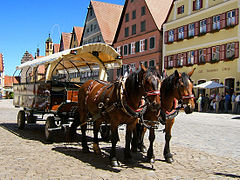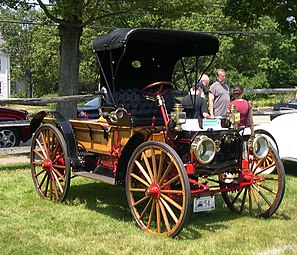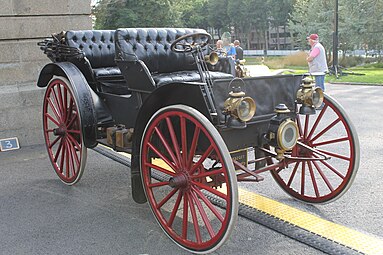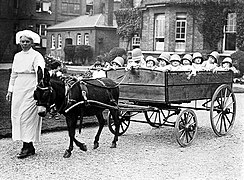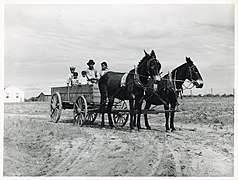Wagon

A wagon or waggon is a heavy four-wheeled vehicle pulled by draught animals or on occasion by humans, used for transporting goods, commodities, agricultural materials, supplies and sometimes people.
Wagons are immediately distinguished from carts (which have two wheels) and from lighter four-wheeled vehicles primarily for carrying people, such as carriages. Animals such as horses, mules, or oxen usually pull wagons. One animal or several, often in pairs or teams may pull wagons. However, there are examples of human-propelled wagons, such as mining corfs.
A wagon was formerly called a wain and one who builds or repairs wagons is a wainwright. More specifically, a wain is a type of horse- or oxen-drawn, load-carrying vehicle, used for agricultural purposes rather than transporting people. A wagon or cart, usually four-wheeled;[1] for example, a haywain, normally has four wheels, but the term has now acquired slightly poetical connotations, so is not always used with technical correctness. However, a two-wheeled "haywain" would be a hay cart, as opposed to a carriage. Wain is also an archaic term for a chariot. Wain can also be a verb, to carry or deliver, and has other meanings.
Contemporary or modern animal-drawn wagons may be of metal instead of wood and have regular wheels with rubber tires instead of traditional wagon wheels.
A person who drives wagons is called a "wagoner",[2][3] a "teamster", a "bullocky" (Australia), a "muleteer", or simply a "driver".
Wagons have served numerous purposes, with numerous corresponding designs.[4] As with motorized vehicles, some are designed to serve as many functions as possible, while others are highly specialized.
Terminology and design
[edit]
The exact name and terminology used are often dependent on the design or shape of the wagon. If low and sideless it may be called a dray, trolley or float.[6]: 68, 79, 165 When traveling over long distances and periods, wagons may be covered with cloth to protect their contents from the elements; these are "covered wagons". If it has high sides, with or without a permanent top, it may be called a "van".[6]: 167 A wagon might be unsprung if ordinarily used over rough ground or cobbles.[7]: 442
A front axle assembly, in its simplest form, is an assembly of a short beam with a pivot plate, two wagon wheels and spindles as well as a drawbar attached to this. A pin attaches the device to a chariot, a wagon or a coach, making the turning radius smaller.[4]
Types
[edit]Farm wagon
[edit]Farm wagons are built for general multi-purpose usage in an agricultural or rural setting. These include gathering hay, crops and wood, and delivering them to the farmstead or market.[4] Wagons can also be pulled with tractors for easy transportation of those materials.
A common form found throughout Europe is the ladder wagon, a large wagon the sides of which often consisted of ladders strapped in place to hold in hay or grain, though these could be removed to serve other needs.[4] A common type of farm wagon particular to North America is the buckboard.
Freight wagon
[edit]Freight wagons were used for the overland hauling of freight and bulk commodities.[8] They were not designed for transporting people and were not built for comfort. Many were constructed without a driver's seat or bench, leaving the driver to walk alongside the wagon or ride atop of one of the horses. Many freight wagons had a "lazyboard," a plank that could be pulled out for sitting upon then pushed back when not needed. In America, lazyboards were located on the left side and close to the brake because wagons were steered from the left side; the opposite was practiced in Great Britain.[9][10]: x, 96
In the United States and Canada, the large, heavily built Conestoga wagon was a predominant form of freight wagon in the late 18th and 19th centuries, often used for hauling goods on the Great Wagon Road in the Appalachian Valley and across the Appalachian Mountains.
Even larger wagons were built, such as the twenty-mule team wagons, used for hauling borax from Death Valley, which could haul 36 short tons (32 long tons; 33 t) per pair.[11] The wagons' bodies were 16 feet (4.88 m) long and 6 feet (1.83 m) deep; the rear wheels were 7 feet (2.13 m) in diameter, and the wagons weighed 7,800 pounds (3,500 kg) empty.[11][12]
Freight wagons in the American West were hauled by oxen, mules or horses. Freight wagon teams would generally haul between three and thirty-five tons of freight when hauling to mining outposts. On the return, they would haul ore to steamboats or to railroad depots.[13]
-
Conestoga wagon, USA 1840s
-
Ox-wagon hauling wool, New Zealand c. 1880
-
Twenty-mule team, Borax freight, USA 1880s
-
Borax wagons on display c. 1935
-
Freight wagons, USA 1905
-
Freight wagons, Argentina 1920s
-
Load of wheat, USA 1910
Delivery wagon
[edit]A delivery wagon was used to deliver merchandise such as milk, bread, produce, meat and ice to residential and commercial customers, predominantly in urban settings. The concept of express wagons and of paneled delivery vans developed in the 19th century.[7]: 441–5 By the end of the 19th century, delivery wagons were often finely painted, lettered and varnished, serving as image-builders and rolling advertisements.[14][15] Special forms of delivery wagon include an ice wagon and a milk wagon.
Tank wagons carried liquid cargoes. Water wagons delivered to areas without piped water and for military camp use.[6]: 171 In the early 1900s, the American street flusher used a gas-powered pump to clean city streets of litter or mud, and to wet down dust in dry seasons.[6]: 7, 171 Liquid manure wagons were low tank vehicles for spreading manure on fields in the 1860s-1900s.[6]: 156 Oil wagons operated from the 1880s to 1920s and held up to 500 gallons of oil or spirits.[6]: 123–124
In the city center of Schwäbisch Gmünd, Germany, since 1992 the city's plants are irrigated using a horse-drawn wagon with a water tank.[16]
-
Bakery delivery wagon, Australia 1900s
-
Alcohol tank wagon, France 1900s
-
Store delivery, USA 1900s
-
Bread delivery, England 1910s
-
Milk wagons, Finland 1920s
-
Milk delivery, Canada 1920s
Living accommodations
[edit]Wagons have also served as the first mobile homes, as mobile workshops, and mobile kitchens.
- Shepherd's hut - for remote shepherds
- Vardo - traditional wagon of the 19th-century British Romani people
- Living van - used to house roving work crews during early steam engine days
- Showman's wagon - elaborate living accommodations for showmen
- Chuckwagon - a small wagon used for providing food and cooking; essentially a portable kitchen
-
Shepherd huts
-
A Romani Vardo
-
Showman's wagon
Entertainment and show
[edit]Travelling circuses decorated their wagons to be able to take part in the grand parade—even packing wagons for equipment, animal cage wagons, living vans and band wagons.[6]: 45 Popular in North America was, and still is, the float or show wagon, driven by six horses pulling a highly decorated show wagon with a token payload, and heavily painted with company or owner advertising.[6]: 1 Horse-drawn wagons are popular attractions at tourist destinations for leisurely sightseeing.[6]
-
Pageant wagons, Belgium 1615
-
Circus parade wagon, built 1904
-
Parade float, USA 1908
-
Tourist wagon, USA 2004
-
Sight-seeing wagon, Germany 2008
-
Exhibition wagon, USA 2017
Motorized wagons
[edit]During the transition to mechanized vehicles from animal-powered, vehicles were built by coachbuilders and the bodies and undercarriages were substantially similar to the horse-drawn vehicles.
- Hippomobile - 1860s invention, gas powered
- Steam wagon - late 1800s, large steam-powered vehicle
- Duryea Motor Wagon - 1890s gasoline powered, patterned from the American buggy
- Auto Wagon - early 1900s gas-powered, patterned from the American buggy
- High wheeler - 1910s - often made from converted horse-drawn wagons
In modern times, the term station wagon survives as a type of automobile. It describes a car with a passenger compartment that extends to the back of the vehicle, that has no trunk, that has one or more rear seats that can be folded making space for carrying cargo, as well as featuring an opening tailgate or liftgate.[17]
- Motorized wagons
-
Patent drawing for the Duryea Road Vehicle, 1895
-
George B. Selden driving an automobile in 1905
Modern agricultural wagons
[edit]-
Front unload forage wagon
Wagon train
[edit]
In migration and military settings, wagons were often found in large groups called wagon trains.
In warfare, large groups of supply wagons were used to support traveling armies with food and munitions, forming "baggage trains". During the American Civil War, these wagon trains would often be accompanied by the wagons of private merchants, known as sutlers, who sold goods to soldiers, as well as the wagons of photographers and news reporters.[18] Special purpose-built support wagons existed for blacksmithing, telegraphy and even observation ballooning.[19]
In migration settings, such as the emigrant trails of the American West and the Great Trek of South Africa, wagons would travel together for support, navigation and protection. A group of wagons may be used to create an improvised fort called a laager, made by circling them to form an enclosure. In these settings, a chuckwagon is a small wagon used for providing food and cooking, essentially a portable kitchen.
Draught animals
[edit]In addition to horses and oxen, animals such as mules and goats have been used as draught animals for appropriately-sized wagons.
-
Sheep and children's wagon (1883)
-
Goat pair and wagon (1917)
-
Donkey and wagon full of children (1925)
-
Mule team and wagon (1939)
-
Oxen and covered wagon (1951)
Wagons in art
[edit]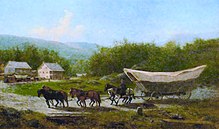
As a common, important element in history and life, wagons have been the subjects of artwork. Some examples are the paintings The Hay Wain and The Haywain Triptych, and on the Oregon Trail Memorial half dollar.
See also
[edit]References
[edit]- ^ "wain n 1". Oxford English Dictionary (2nd ed.). Oxford University Press. 1989.
- ^ "Wagoner". Merriam-Webster. Retrieved 29 January 2017.
- ^ "Wagoner". The Free Dictionary. Retrieved 29 January 2017.
- ^ a b c d "Waggon". Rees's Cyclopædia. Vol. 37. London: Longman, Hurst, Rees, Orme & Brown. 1817–1818.
- ^ "4,000 Years Old Wagons Found in Lchashen, Armenia". Art-A-Tsolum. 28 December 2017. Retrieved 13 May 2022.
- ^ a b c d e f g h i Smith, D.J.M. (1988). A Dictionary of Horse Drawn Vehicles. J. A. Allen & Co. Ltd. ISBN 0851314686. OL 11597864M.
- ^ a b Stratton, Ezra M. (1878). The World on Wheels; or, Carriages, with their Historical Associations from the Earliest to the Present Time, Including a Selection from the American Centennial Exhibition. New York: The author. OCLC 3570369. OL 7004294M.
- ^ Gardner, Mark L. (September 1997). "Wagons on the Santa Fe Trail: 1822-1880" (PDF). National Park Service. Archived from the original (PDF) on 17 October 2013. Retrieved 5 February 2013.
- ^ Burt, Olive W. (1962). John Wanamaker: Boy Merchant. New York: Bobbs-Merrill. p. 62. OL 5855211M.
- ^ Berkebile, Donald H. (1989). Horse-drawn Commercial Vehicles. Dover Publications. ISBN 0486260208. OL 2209008M.
- ^ a b "Twenty Mule Teams". Death Valley National Park. National Park Service. Retrieved 6 February 2013.
- ^ "Borax: The Twenty Mule Team". Archived from the original on 25 September 2008. Retrieved 18 September 2008.
- ^ Carter, Gary. "Heavy Freight Wagons of the American West". Western Mining History. Retrieved 14 September 2024.
- ^ Hillick, M.C. (1898). Practical Carriage and Wagon Painting. Chicago: Press of the Western Painter. pp. 2, 109–116.
- ^ Sanders, Walter R. (1922). Ice Delivery. Chicago: Nickerson & Collins. pp. 170–172.
- ^ "Ein PS für 160 Blumenkübel" [One horsepower for 160 flower pots]. Gmünder Tagespost (in German). 31 July 2015. Archived from the original on 11 December 2019. Retrieved 25 February 2022.
- ^ "Definition: station wagon". Merriam-Webster.com. Retrieved 9 December 2019.
- ^ O'Sullivan, Timothy (1863). "Bealton, VA". Library of Congress Prints & Photographs. Retrieved 5 February 2013.
- ^ "Thaddeus Lowe with his Inflation Wagons". Smithsonian Institution: National Air and Space Museum. Retrieved 5 February 2013.
External links
[edit] The dictionary definition of wagon at Wiktionary
The dictionary definition of wagon at Wiktionary Media related to Wagons at Wikimedia Commons
Media related to Wagons at Wikimedia Commons- Chisholm, Hugh, ed. (1911). . Encyclopædia Britannica (11th ed.). Cambridge University Press.






















